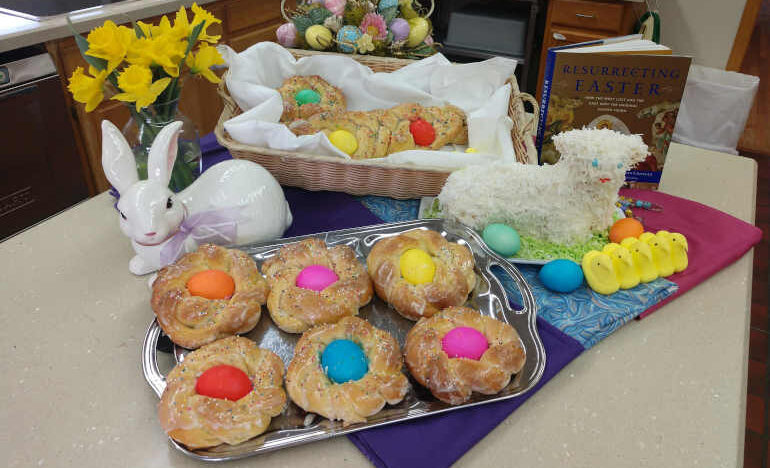From the Heart: Contemplative Communication

By Kathy Keary
The Circle is a method of contemplative communication where members find themselves totally present to others. Participants not only speak from the heart but also listen from the heart. It’s an effective tool in a spiritual, family, or secular setting and can be used for many purposes including healing, reconciliation, community building, managing conflict, and bonding.
Beginning the Circle with a simple ritual to honor the time and space as hallowed transforms the environment into a sanctuary where sharing one’s truth is held sacred. The setting increases the likelihood for members to experience a connection with the Spirit as well as one another. The invited guest is the authentic self — the person that one is before God — the true self.
Simple guidelines foster compassionate communication. A talking piece is used. Only the person with the talking piece speaks. Stories are told and emotions are shared as the speaker goes to a place deep within, echoing the words they discover in the depths of their soul. Often the speaker is surprised at what surfaces. One typically begins to trust the words that are born from a place that Jesus referred to in the Gospel of Matthew as the “inner room.” In the words of David Whyte, an English poet and author of the book, The Heart Aroused: “The voice emerges from the body as a representation of our inner world. It carries our experience from the past, our hopes and fears for the future, and the emotional resonance of the moment.”
Listen Deeply
In our culture, it is commonplace to listen with the intent to respond or critique a speaker’s words. In the Circle, we do not verbally respond to the speaker. We learn a new way of listening from a place deep within totally consumed by the speaker’s words and emotions. As stated in Wisdom Circles: A Guide to Self-Discovery and Community Building in Small Groups by Charles Garfield, Cindy Spring, and Sedonia Cahill:
Listening from the heart means you give a “welcome” sign to the speaker, who’s wondering whether to trust you with his or her thoughts and feelings. Through your respectful silence, eye contact, body posture, and attentiveness, you signal that you are listening with empathy. Such heartfelt concentration creates a space in which each member of the circle can speak freely, feeling like an invited guest.
We honor the inherent dignity of the speaker by being truly present to their words and emotions. Rachel Naomi Remen writes about this in her book, Kitchen Table Wisdom: “When we are seen by the heart, we are seen for who we are. We are valued in our uniqueness by those who are able to see us in this way and we become able to know and value ourselves.”
Embrace Silence
In the Circle, a deeper form of communication occurs and group solidarity is fostered. In the process, participants are opened to a deeper message as universal themes surface. The art of speaking from the heart and listening from the heart expands the participants’ capacity for unconditional love. Concerns of those in the Circle become the concerns of other Circle members.
Silence is a key ingredient in a Circle. It creates an atmosphere where our inner wisdom can be heard resulting in more intuitive responses. The authors of Wisdom Circles explain: “Like the space between musical notes or the white of a Chinese watercolor, the emptiness is as important as the other major elements. We need to know how to empty ourselves so that new thoughts, feelings, and images may rise from the unconscious.”
The silence creates a soul connection with others. We discover that it is not only the words that nourish us but also the silence. Be moved by the words of Thomas Keating in Open Mind Open Heart:
Interior silence is the perfect seed bed for divine love to take root. In the Gospel the Lord speaks about a mustard seed as a symbol of divine love. It is the smallest of all seeds, but it has an enormous capacity for growth. Divine love has the power to grow and transform us.
Express Gratitude
Another key element of the Circle is the expression of gratitude, a virtue that enriches the life of the soul. In the words of the seventeenth century English poet, John Milton: “Gratitude bestows reverence, allowing us to encounter everyday epiphanies, those transcendent moments of awe that change forever how we experience life and the world.” Expressing thanksgiving colors the Circle with an uplifting positivity that will spill over into one’s everyday life.
Sharing and listening from the heart in a sacred environment is an exercise in practical compassion as we bow to the Divine Wisdom of another. We care for one another when we engage in contemplative communication. It is common for the rich spirituality of the Circle to carry over into one’s interactions with those outside of the Circle manifesting itself in the expression of greater love, compassion, and reverence for others.
In my next article, I will outline the 10 important elements to include in a Circle. I am available to assist you in holding Circles in your particular setting.
Note: New articles in this series are posted to the website every Monday. The full series can be found here: An Invitation to Something New: The Contemplative Life. On Thursday’s we’ll send an email to remind you of the articles.
Never miss an article published to the Renewal Center website: Sign up to receive our newsletters.
[Kathy Keary, a Precious Blood Companion and spiritual director, holds a master’s degree in theological studies and is a graduate of the Atchison Benedictine’s Sophia Center’s Souljourners Program, an intense study of spirituality and spiritual direction. Kathy believes that the divine is present and active in all of life and encourages others to be awakened to the God in all including the divine within. She enjoys accompanying others on their journey to wholeness discovering the person they were created to be.]
Related

Easter Bread (Pane di Pasqua)
By Lucia Ferrara
Easter bread is a fun bread. It’s a fun bread to make with your children, with your family, with neighbors and friends. The tradition of Easter bread dates back centuries and comes from many parts of the world.

Easter Sunday, the Resurrection of the Lord
Today’s scriptures tell us how three days changed the world. How have they changed you?
Categories
Assembling God's Puzzle Coffee with Padre Cooking & Spirituality Encounters of the 4th Kind Family Matters Reflections on the Eucharsitic Prayers Spiritual Resources Taize Prayers The Contemplative Life Traveling with Pilgrims of Hope Uncategorized Videos Week of Prayer for Uhristian Unity When you need a little help
